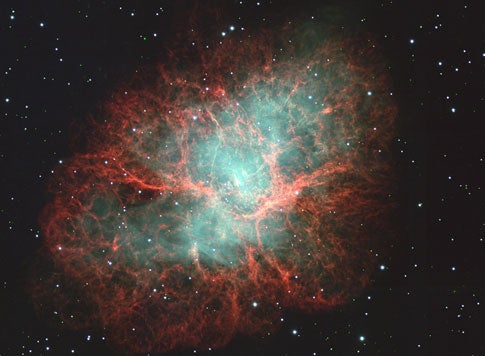The research was led by Gwen Rudie, a senior physics major at Dartmouth. She and her adviser, Robert Fesen, along with Toru Yamada from Japan’s Subaru Observatory in Hawaii, used photographs taken 17 years apart to study the expansion speed of the Crab Nebula, in results released May 29 in Honolulu at the 210th meeting of the American Astronomical Society.
These astronomers found that the outermost part of the supernova remnant, a very faint “jet” of stellar debris, shows clearly for the first time that the Crab exploded around the middle of the 11th century, in perfect accord with historic records. “For the past 100 years astronomers have puzzled over the discrepancy between the measured age of the Crab Nebula versus the age suggested by numerous historical sightings around the ancient world,” Rudie said. “This work verifies some long-standing assumptions about the nature of the Crab — with our result, science and history finally agree.”
The Crab Nebula is one of the most studied remains of a stellar explosion and is widely accepted to be due to a supernova seen in the year 1054 a.d. by Chinese, Japanese, Korean, and Arab astronomers, who reported sighting a new bright star in the heavens. The star was so brilliant that it was visible even during the day for nearly three weeks and only faded from view nearly two years later.
While the Crab Nebula’s location in the sky agreed very well with the reported position of this bright new star, several studies of the expanding cloud of stellar debris unexpectedly indicated that it was expanding much too fast to be associated with a supernova explosion in 1054. Instead, these studies pointed later in time, toward an explosion date in the first half of the 12th century.
This dilemma led astronomers to the idea that the remnant’s central pulsar — the rapidly spinning and extremely dense neutron star left over from Crab’s supernova explosion — emitted such copious amounts of energy that it actually accelerated the expanding cloud of debris, making it move faster with time.
“Previous studies have focused on the main body of the Crab Nebula, which has been accelerated with time,” Rudie explained. “We chose to look at the northern jet because it is farther from the pulsar. That was the key to our new age determination.”










